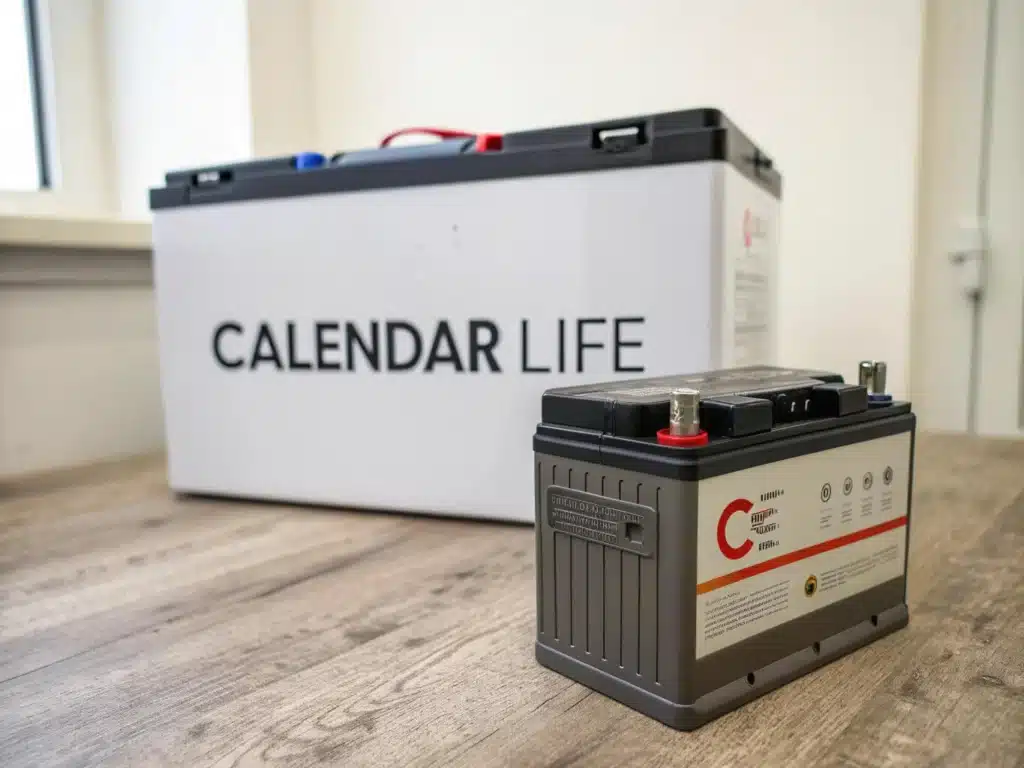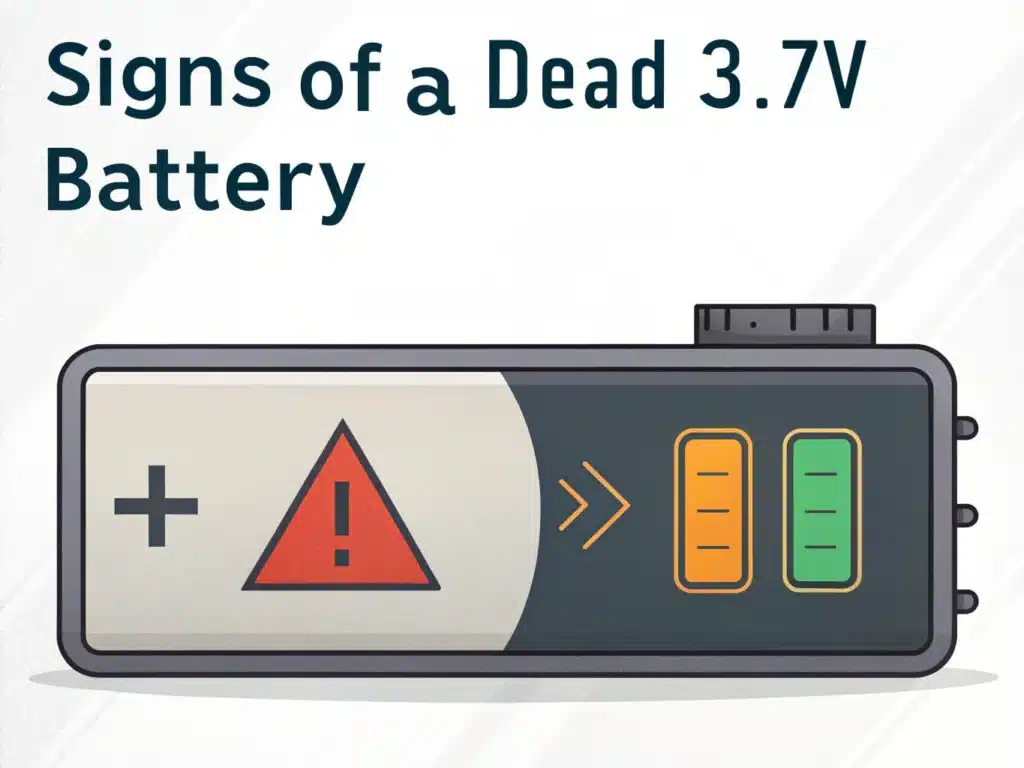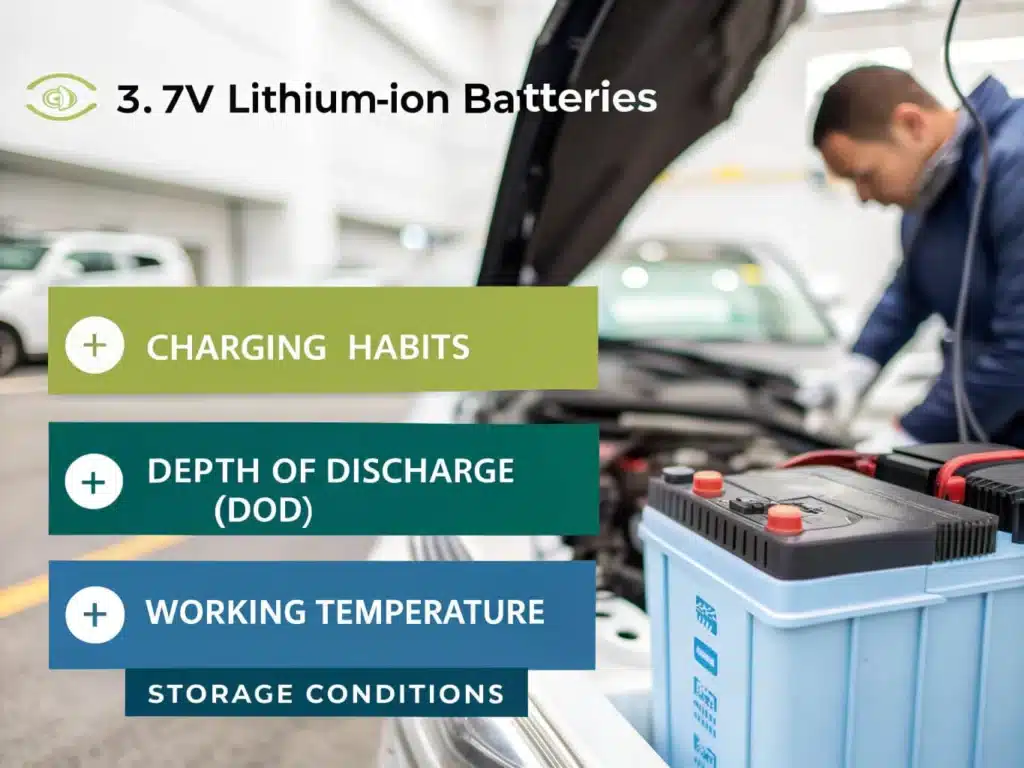In fact, you can’t tell by simply looking at the 3.7V battery. This is just the nominal voltage of the battery. It’s like saying it’s a car, but you don’t know how big the fuel tank is or how much fuel it consumes. If you want to know how long a 3.7 lithium battery can last after a full charge, it mainly depends on the capacity (mAh) and the operating current. As for how many years a 3.7V lithium battery can last (lifespan), it mainly depends on its number of cycles and how you usually use it. You can find the answers in this article.
Table of Contents
ToggleHow long can a 3.7V battery last
How long can a device continue to work after a full charge of an 18650 3.7V battery? This is like asking “how far can a tank of gas run?” To answer this question, the following 2 core factors really play a decisive role:
Battery capacity
Battery capacity is usually expressed in mAh (milliampere-hour) or Wh (watt-hour). It represents the total amount of energy that the battery can store. This is the core parameter that determines the battery life. You can think of it as the size of a car’s gas tank or the capacity of a water cup. For the same 3.7V lithium battery, a 2000mAh battery stores about twice as much energy as a 1000mAh battery. When loaded with the same device, the former will theoretically last twice as long as the latter.
Device power consumption
Device power consumption refers to the rate at which your device consumes electrical energy when it is working, usually expressed in mA (milliamperes), A (amperes), or W (watts). This determines how quickly the energy in the battery is consumed. You can think of it like the fuel consumption of a car (how much fuel is consumed per 100 kilometers) or the speed at which the tap drains.
For example, the same 2000mAh battery may only last for 2 hours if used in a flashlight at high brightness (which may consume 1000mA of current); but if used in a low-power Bluetooth sensor (which may only consume 100mA of current), it can theoretically last for 20 hours.
Therefore, to estimate the life of a 3.7V battery, you can use the following formula:
Based on current: Endurance time (hours) = battery capacity (Ah) / average operating current of the device (A)
Based on power consumption: Battery life (hours) = battery energy (Wh) / device average power (W)
Total 3.7V battery lifespan
In addition to how long a single charge can last, you may also be concerned about how many years a battery can last, or how many times it can be charged and discharged before it ends. How long a 3.7V battery can last depends mainly on the following two aspects of aging:
Cycle life

Each time a battery is fully charged and discharged, it is considered a cycle. However, there will be a little loss inside it. Generally, the 500 cycles mentioned by lithium battery factories do not mean that the battery cannot be used after 500 cycles, but that the battery is no longer durable. Even if fully charged, it can only store about 80% of the original power of a new battery. At this point, the battery life is significantly shortened.
Calendar life

Even if your lithium battery is not used, it will age. This is called calendar life. The chemicals in the battery will also start to react over time. Generally, a 3.7V battery can last for two to three years.
Therefore, the total life of the battery depends not only on how many cycles you use it, but also on how long it is stored and how it is stored. These two aspects together determine how long your battery will ultimately last.
Signs of a dead 3.7V battery
When your device uses a lithium-ion or lithium-polymer battery with a nominal voltage of 3.7V, you can tell that the battery is almost exhausted by the following signs.

The device automatically shuts down or stops working: This is the most direct and common sign. When the battery voltage drops to the discharge cut-off voltage required for the device to operate (usually set by the battery protection board or the low-voltage protection circuit of the device itself, which may be 3.0V – 3.2V), the device will actively shut down to protect the battery from over-discharge damage.
Low battery warning reminder: Most modern electronic devices have a low battery warning function. This may appear as a low battery icon, a very low battery percentage, a text warning message, or a sound prompt.
Significant decrease in device performance: Some devices may enter “power saving mode” where the screen brightness is automatically reduced, processing speed is slowed, or certain power-intensive features are disabled.
The device will not turn on: If the device is already powered off and the battery is exhausted, pressing the power button will have no effect, or the screen may light up briefly to display an empty battery icon before turning off again.
Abnormal charging indication (extreme case): If your phone is over-discharged, the phone may not respond at all when you plug it into the charger again, and it may take a long pre-charging process to return to normal charging status.
Factors affecting the life of 3.7V lithium-ion batteries
Batteries are consumables with a limited lifespan, but good usage habits can significantly extend their effective working time and make your device more durable. The following are the main influencing factors:

Optimize charging habits: Avoid long-term overcharging. After the battery is fully charged to 100%, continuously connecting the charger will put a little pressure on the battery, especially at high temperatures. Although modern devices have protection mechanisms, there is no need to keep them plugged in unless necessary.
Avoid deep over-discharge: Try not to wait until the device is completely out of power and automatically shuts down before charging. Lithium batteries do not have a “memory effect” and “shallow charging and shallow discharge” (maintaining a power level between 20%-80%) is more beneficial to prolonging life. It is a good habit to charge as you use it.
Stay away from extreme temperatures: Batteries work most efficiently and have the longest life in a suitable temperature range (0°C ~ 35°C).
Keep away from high temperatures: Whether working, charging or storing, avoid exposing the device to high temperatures for a long time (such as in a car under direct summer sun, near a heat source). High temperatures will accelerate the aging of the chemical substances inside the battery.
Keep away from low temperatures: At extremely low temperatures, battery performance will temporarily decline (capacity decreases, internal resistance increases), charging will slow down or even fail to charge. Avoid forced charging or high-load use in cold environments, and performance will recover after the temperature rises.
Long-term storage: If the device or battery is not used for a long time, it is recommended to charge it to 40%-60%.
Storage environment: Store it in a cool, dry place.
Avoid fully charged/depleted storage: Never store the battery fully charged (100%) or completely depleted (0%) for a long time, as both states will accelerate the natural aging of the battery.
Original or certified charger: Make sure the charger meets the specifications and provides a stable, correct charging voltage and current. Poor quality chargers may damage the battery.
How to maximize the life of 3.7V lithium batteries
To maximize the use of your 3.7V lithium battery, provide long-lasting and reliable power, and ensure safe use, please refer to the following tips:

Capacity: This is the key indicator that determines the battery life on a single charge. Choose a battery with the right capacity based on your device’s power consumption and expected runtime. The larger the capacity, the better. Consider size, weight, and cost. We can customize our own 3.7V lithium battery.
Choose reputable brands: They usually have strict quality control, true capacity labeling, and better safety performance. Avoid buying batteries from unknown sources or abnormally low prices. For example, Hongyitai is a professional lithium battery factory in China.
Understand device power consumption: Get a clear understanding of the approximate power consumption of your device in different modes (for example, screen brightness, wireless connection, processor load, etc.), which will help you reasonably estimate the actual battery life and adjust your usage as needed to save power.
Develop good charging habits: Shallow charging and shallow discharging are recommended to avoid long-term overcharging and deep over-discharging.
Reasonable ambient temperature: Try to use and charge at room temperature and avoid high temperature environments.
If you find that the battery life after being fully charged is significantly shorter than before, this is usually a sign of normal battery aging. Consider replacing the battery with a new one to restore battery life.
If you find that the battery is swollen, leaking, has an odor, has a damaged shell, or is abnormally hot, please stop using the battery immediately.
From checking at the source of purchase, to careful daily use, to timely detection and handling of problems, they all affect whether you can fully and safely realize the value of your 3.7V lithium battery.
Summarize
How long your 3.7V lithium battery can last is determined by the above multiple interrelated factors. By understanding these determining factors, you can more wisely choose the lithium battery that suits your needs and effectively extend its service life through simple maintenance measures in daily use.
FAQs
Typically, a 3.7V Li-Ion battery is considered fully discharged or "dead" when the voltage drops to around 2.5V to 3.0V. The battery management system (BMS) built into most devices will cut power before this point to prevent over-discharge from damaging the battery. Discharging the voltage much below this range can damage the battery.
"Average life expectancy" is affected by many factors and there is no absolute uniform value. Generally speaking:
Calendar life: Even with infrequent use, natural aging occurs within approximately 2 to 5 years from the date of manufacture.
Based on the charge and discharge cycle life: about 300 to 1000+ charge and discharge cycles, the capacity drops to 80% of the initial capacity. Good maintenance (such as avoiding extreme temperatures and shallow charging and discharging) can help extend the life.
A typical 3.7V Li-ion battery can go through about 300 to 1000+ complete charge and discharge cycles before performance (primarily capacity) begins to degrade noticeably (usually defined as less than 80% of initial capacity). The actual number is highly dependent on depth of discharge (shallower is better), operating temperature, and charging habits.
